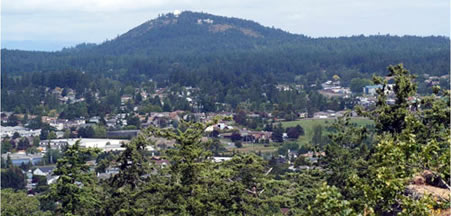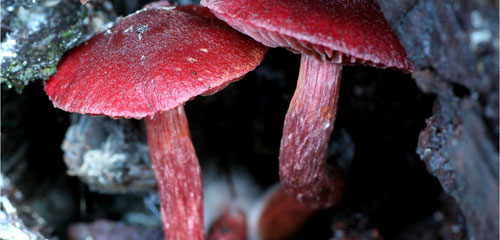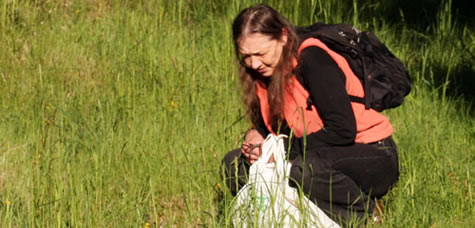THE MACROFUNGI OF OBSERVATORY HILL

Observatory Hill, Saanich, British Columbia. Photo: Adolf Ceska.
Adapted from the GOERT website, with permission.
[Victoria botanist Oldriska (Oluna) Ceska has been surveying the fungi of Observatory Hill since March 2004. Here is a brief account of her work, adapted from a BEN article, June 2009 (Botanical Electronic News).
THE MACROFUNGI OF OBSERVATORY HILL: LONG-TERM SURVEY AND INVENTORY 2004-2010
by Oluna Ceska
Observatory Hill (also known as Little Saanich Mountain) is a hill on the outskirts of Victoria, BC, Canada, elevation 224 m. In 1913, Canadian astronomer J.S. Plaskett selected this hill as a site for a large, 1.83 m telescope. The observatory and the telescope were finished in April 1918. Later the top of the hill was developed into an astronomical research and educational facility. Since 1995, Observatory Hill has been the site of the NRC Herzberg Institute of Astrophysics.
The research facilities are clustered on the top of the hill, and relatively large areas have been left undeveloped in order to provide good conditions for astronomical observation.
The plant communities that remain on the hill are typical of the Coastal Douglas-Fir Biogeoclimatic Zone. The drier western and southern upper slopes are open rock outcrops with a mosaic of mossy/grassy vegetation and several stands of Garry oak, with scattered clusters of arbutus. On the top of the hill there are remnants of an old-growth Douglas-fir forest, rare on southern Vancouver Island.

The fungus Tubaria punicea growing at the base of an arbutus tree on
Observatory Hill.
Photo: Adolf Ceska.
With the exception of Hans Roemer’s work, there has been no detailed study of the plant communities of Observatory Hill. Dr. Roemer included 10 vegetation sample plots from Observatory Hill in his Ph.D. thesis and has done additional studies of rare plant habitat on the western slope.
The western slope of the hill hosts several rare species of vascular plants, bryophytes, insects, and vertebrates. Many of them have been recorded in the Species At Risk Act (SARA) registry. Most of the rare species occur on the rock outcrops and in the Garry oak stands on the western slope.
Observatory Hill has been of interest to Victoria botanists since the beginning of the 20th century. C.F. Newcombe, R.J. Anderson and G. Hardy collected vascular plants on the western slope of Observatory Hill and recorded several plants rare in British Columbia that are still studied and monitored today: Allium amplectens, Meconella oregana, Idahoa scapigera, Lomatium dissectum, Lupinus lepidus, Psoralea (Rupertia) physodes, Sericocarpus rigidus (Aster curtus) and Viola praemorsa.
Recently, bryologists have been monitoring two rare bryophytes (Bartramia stricta andEntosthodon fascicularis) that have been discovered on the western slope of Observatory Hill, in addition to the uncommon Sphaerocarpos texanus and Targionia hypophylla. Not much attention has been paid to other parts of Observatory Hill, or to the fungi.

Oldriska (Oluna) Ceska. Photo: Adolf Ceska.
In this survey, I used the Intuitive Controlled Survey Method which calls for the qualified surveyor to conduct a survey of the area by walking through it and around its perimeters, and closely examining portions where target species are especially likely to occur. I endeavoured to cover all the possible habitats and substrates. Fungal surveys require repeated sampling throughout the season because many fungi exhibit ephemeral fruiting. Long-term surveys are needed in order to obtain a “complete” list of macrofungi from a given area.
Each species encountered was recorded on each visit and specimens of those that needed microscopic examination for identification were collected. Selected specimens were photographed, preferably in their original setting. There are many photos in the full report. Follow-up laboratory work included sorting, identification and drawing, drying, and storing. It is generally accepted that 1 hour in the field requires 3-4 hours work in the lab.
From November 27, 2004 to March 31, 2010, I made 163 collecting visits to Observatory Hill and recorded/collected about 900 species of fungi. The species observed could be considered representative of the mycoflora of many similar sites in the Coastal Douglas-fir Biogeoclimatic Zone on southern Vancouver Island. Many species represent northern extensions of species otherwise known from more southern ranges and the preliminary study of the Observatory Hill specimens has revealed at least one previously undescribed species.
Results of each season’s work are summarized in an annual report that is submitted to the Dominion Astrophysical Observatory. The reports from 2004-present are available as pdf files below.
Observatory Hill has proven to be ideal for a long-term mycological inventory as it is protected to a certain degree, it is easily accessible and the size of the area is about as much as one mycologist can cover in an intensive season of field work. I hope that this work will be the beginning of long-term monitoring of the mycoflora of the Coastal Douglas-fir Biogeoclimatic Zone.
Read the 2004 - 2009 report here (PDF).
Read the 2009-2010 report here.
Read the 2010-2011 report here.
Read the 2011-2012 report here.
Recommended citation: Author, date, page title. In: Klinkenberg, Brian. (Editor) 2021. E-Flora BC: Electronic Atlas of the Flora of British Columbia [eflora.bc.ca]. Lab for Advanced Spatial Analysis, Department of Geography, University of British Columbia, Vancouver. [Date Accessed]
E-Flora BC: An initiative of the Spatial Data Lab, Department of Geography UBC, and the UBC Herbarium.
© Copyright 2021 E-Flora BC.